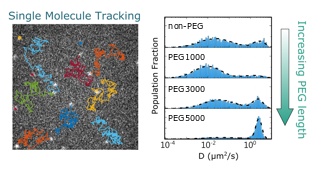
Native cell membrane derived supported lipid bilayers (SLBs) are emerging platforms that have broad applications ranging from fundamental research to next-generation biosensors. Central to the success of the platform is proper accommodation of membrane proteins so that their dynamics and functions are preserved. Polymer cushions have been commonly employed to avoid direct contact of the bilayer membrane to the supporting substrate, and thus the mobility of transmembrane proteins is maintained. However, little is known about how the polymer cushion affects the absolute mobility of membrane molecules. Here, we characterized the dynamics of single membrane proteins in polymer-cushioned lipid bilayers derived from cell plasma membranes and investigated the effects of polymer length. Three membrane proteins of distinct structures, i.e., GPI-anchored protein, single-pass transmembrane protein CD98 heavy chain, and seven-pass transmembrane protein SSTR3, were fused with green fluorescence proteins (GFPs) and their dynamics were measured by fluorescence single-molecule tracking. An automated data acquisition was implemented to study the effects of PEG polymer length to protein dynamics with large statistics. Our data showed that increasing the PEG polymer length (molecular weight from 1,000 to 5,000) enhanced the mobile fraction of the membrane proteins. Moreover, the diffusion coefficients of transmembrane proteins were raised by increasing the polymer length, whereas the diffusion coefficient of GPI-anchored protein remained almost identical with different polymer lengths. Importantly, the diffusion coefficients of the three membrane proteins became identical (2.5 μm2/s approximately) in the cushioned membrane with the longest polymer length (molecular weight of 5,000), indicating that the SLBs were fully suspended from the substrate by the polymer cushion at the microscopic length scale. Transient confinements were observed from all three proteins, and increasing the polymer length reduced the tendency of transient confinements. The measured dynamics of membrane proteins were found to be nearly unchanged after depletion of cholesterol, suggesting that the observed immobilization and transient confinement were not due to cholesterol-enriched membrane nanodomains (lipid rafts). Our single-molecule dynamics elucidate the biophysical properties of polymer cushioned plasma membrane bilayers that are potentially useful for future developments of membrane-based biosensors and analytical assays.
